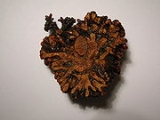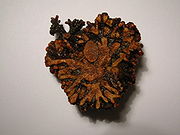
Frankia
Encyclopedia
Frankia is a genus of nitrogen fixing
, filamentous
bacteria that live in symbiosis
with actinorhizal plants
, similar to the Rhizobia
bacteria that are found in the root nodules of legumes in the Fabaceae
family. Bacteria of this genus also form root nodule
s.
The genus Frankia was originally named by Jørgen Brunchorst
in 1886 to honor the German biologist, A. B. Frank. Brunchorst considered the organism that he had identified to be a filamentous fungus. Becking redefined the genus in 1970 as containing prokaryotic
actinomycetes
and created the family Frankiaceae within the Actinomycetales
. He retained the original name of Frankia for the genus.

in this genus
but there are a great many strains
specific to different plant species. The bacteria are filamentous and convert atmospheric nitrogen into ammonia, a process known as nitrogen fixation. They do this while living in root nodules on actinorhizal plants. The bacteria can supply most or all of the nitrogen requirements of the host plant. As a result, actinorhizal plants colonise and often thrive in soils that are low in plant nutrients.
Several Frankia genomes are now available which may help clarify how the symbiosis between prokaryote
and plant evolved, how the environmental and geographical adaptations occurred, the metabolic diversity and the horizontal gene flow among the symbiotic prokaryotes.
Nitrogen fixation
Nitrogen fixation is the natural process, either biological or abiotic, by which nitrogen in the atmosphere is converted into ammonia . This process is essential for life because fixed nitrogen is required to biosynthesize the basic building blocks of life, e.g., nucleotides for DNA and RNA and...
, filamentous
Filamentation
Filamentation is the anomalous growth of certain bacteria, such as E. coli, in which cells continue to elongate but do not divide . Bacterial filamentation is often observed as a result of bacteria responding to various stresses, including DNA damage or inhibition of replication...
bacteria that live in symbiosis
Symbiosis
Symbiosis is close and often long-term interaction between different biological species. In 1877 Bennett used the word symbiosis to describe the mutualistic relationship in lichens...
with actinorhizal plants
Actinorhizal plant
Actinorhizal plants are a group of angiosperms characterized by their ability to form a symbiosis with the nitrogen fixing actinobacteria Frankia...
, similar to the Rhizobia
Rhizobia
Rhizobia are soil bacteria that fix nitrogen after becoming established inside root nodules of legumes . Rhizobia require a plant host; they cannot independently fix nitrogen...
bacteria that are found in the root nodules of legumes in the Fabaceae
Fabaceae
The Fabaceae or Leguminosae, commonly known as the legume, pea, or bean family, is a large and economically important family of flowering plants. The group is the third largest land plant family, behind only the Orchidaceae and Asteraceae, with 730 genera and over 19,400 species...
family. Bacteria of this genus also form root nodule
Root nodule
Root nodules occur on the roots of plants that associate with symbiotic nitrogen-fixing bacteria. Under nitrogen-limiting conditions, capable plants form a symbiotic relationship with a host-specific strain of bacteria known as rhizobia...
s.
The genus Frankia was originally named by Jørgen Brunchorst
Jørgen Brunchorst
Jørgen Brunchorst was a Norwegian natural scientist, politician and diplomat. Brunchorst was born in Bergen, the son of ship builder and –captain Christian Ege Brunchorst and his wife Emma Wesenberg . He specialised in botany at university, and after finishing his Ph.D. in Germany, he became...
in 1886 to honor the German biologist, A. B. Frank. Brunchorst considered the organism that he had identified to be a filamentous fungus. Becking redefined the genus in 1970 as containing prokaryotic
Prokaryote
The prokaryotes are a group of organisms that lack a cell nucleus , or any other membrane-bound organelles. The organisms that have a cell nucleus are called eukaryotes. Most prokaryotes are unicellular, but a few such as myxobacteria have multicellular stages in their life cycles...
actinomycetes
Actinobacteria
Actinobacteria are a group of Gram-positive bacteria with high guanine and cytosine content. They can be terrestrial or aquatic. Actinobacteria is one of the dominant phyla of the bacteria....
and created the family Frankiaceae within the Actinomycetales
Actinomycetales
Actinomycetales is an order of Actinobacteria. They are very diverse and contain a variety of subdivisions as well as yet unclassified isolates. This is mainly because some genera are very difficult to classify because of a highly niche-dependent phenotype...
. He retained the original name of Frankia for the genus.

Overview
Frankia alni is the only named speciesSpecies
In biology, a species is one of the basic units of biological classification and a taxonomic rank. A species is often defined as a group of organisms capable of interbreeding and producing fertile offspring. While in many cases this definition is adequate, more precise or differing measures are...
in this genus
Genus
In biology, a genus is a low-level taxonomic rank used in the biological classification of living and fossil organisms, which is an example of definition by genus and differentia...
but there are a great many strains
Strain (biology)
In biology, a strain is a low-level taxonomic rank used in three related ways.-Microbiology and virology:A strain is a genetic variant or subtype of a micro-organism . For example, a "flu strain" is a certain biological form of the influenza or "flu" virus...
specific to different plant species. The bacteria are filamentous and convert atmospheric nitrogen into ammonia, a process known as nitrogen fixation. They do this while living in root nodules on actinorhizal plants. The bacteria can supply most or all of the nitrogen requirements of the host plant. As a result, actinorhizal plants colonise and often thrive in soils that are low in plant nutrients.
Several Frankia genomes are now available which may help clarify how the symbiosis between prokaryote
Prokaryote
The prokaryotes are a group of organisms that lack a cell nucleus , or any other membrane-bound organelles. The organisms that have a cell nucleus are called eukaryotes. Most prokaryotes are unicellular, but a few such as myxobacteria have multicellular stages in their life cycles...
and plant evolved, how the environmental and geographical adaptations occurred, the metabolic diversity and the horizontal gene flow among the symbiotic prokaryotes.
Symbiont plants
- All species in the genus AlnusAlderAlder is the common name of a genus of flowering plants belonging to the birch family . The genus comprises about 30 species of monoecious trees and shrubs, few reaching large size, distributed throughout the North Temperate Zone and in the Americas along the Andes southwards to...
in the BetulaceaeBetulaceaeBetulaceae, or the Birch Family, includes six genera of deciduous nut-bearing trees and shrubs, including the birches, alders, hazels, hornbeams and hop-hornbeams, numbering about 130 species...
family. - Some species in all four genera in the CasuarinaceaeCasuarinaceaeCasuarinaceae is a family of dicotyledonous flowering plants placed in the order Fagales, consisting of 3 or 4 genera and approximately 70 species of trees and shrubs native to the Old World tropics , Australia, and the Pacific Islands...
family. - Certain species in the genus Coriaria CoriariaCoriaria is the sole genus in the family Coriariaceae. It includes about 30 species of subshrubs, shrubs and small trees, with a widespread but disjunct distribution across warm temperate regions of the world, occurring as far apart as the Mediterranean region, southern and eastern Asia, New...
in the Coriariaceae family. - Datisca cannabina and Datisca glomerataDatisca glomerataDatisca glomerata is a species of plant native to California, Nevada, and Baja California known by the common name Durango root. It is one of only two to four species in the plant family Datiscaceae. It is an erect perennial herb with distinctive long, pointed, often sharply serrated leaves. It is...
in the DatiscaceaeDatiscaceaeDatiscaceae are a family of Dicotyledonous plants, containing two species of the genus Datisca. Two other genera, Octomeles and Tetrameles are now classified in the Tetramelaceae family....
family. - All species in the three genera in the ElaeagnaceaeElaeagnaceaeElaeagnaceae, the oleaster family, is a plant family of the order Rosales comprising small trees and shrubs, native to temperate regions of the Northern Hemisphere, south into tropical Asia and Australia. The family has 45-50 species in three genera....
family. These are ElaeagnusElaeagnusElaeagnus , silverberry or oleaster, is a genus of about 50–70 species of flowering plants in the family Elaeagnaceae.The vast majority of the species are native to temperate and subtropical regions of Asia. Elaeagnus triflora extends from Asia south into northeastern Australia, while E...
, Shepherdia and Hippophae. - All species in the genera MyricaMyricaMyrica is a genus of about 35–50 species of small trees and shrubs in the family Myricaceae, order Fagales. The genus has a wide distribution, including Africa, Asia, Europe, North America and South America, and missing only from Australasia...
, MorellaMorella"Morella" is a short story in the Gothic horror genre by 19th-century American author and critic Edgar Allan Poe.-Plot summary:An unnamed narrator marries Morella, a woman with great scholarly knowledge who delves into studies of the German philosophers Fichte and Schelling, dealing with the...
and ComptoniaComptoniaComptonia is a monotypic genus in the family Myricaceae, order Fagales. It is native to eastern North America, from southern Quebec south to the extreme north of Georgia, and west to Minnesota. The common name is Sweetfern or Sweet-fern, a confusing name as it is not a fern.It is a deciduous...
in the family MyricaceaeMyricaceaeThe Myricaceae is a small family of dicotyledonous shrubs and small trees in the order Fagales. There are three genera in the family, although some botanists separate many species from Myrica into a fourth genus Morella...
. - All species in six genera in the RhamnaceaeRhamnaceaeRhamnaceae, the Buckthorn family, is a large family of flowering plants, mostly trees, shrubs and some vines.The family contains 50-60 genera and approximately 870-900 species. The Rhamnaceae have a worldwide distribution, but are more common in the subtropical and tropical regions...
family. These are CeanothusCeanothusCeanothus L. is a genus of about 50–60 species of shrubs or small trees in the buckthorn family Rhamnaceae. The genus is confined to North America, the center of its distribution in California, with some species in the eastern United States and southeast Canada, and others extending as far south...
, ColletiaColletiaColletia is a genus of flowering plants in the family Rhamnaceae, with 15 to 17 species of spiny shrubs. All species of this genus are native to southern South America. They are non-legume nitrogen fixers.-Selected species:*Colletia armata...
, DiscariaDiscariaDiscaria is a genus of about 12 species of flowering plants in the family Rhamnaceae, native to temperate regions of the Southern Hemisphere, in Australia, New Zealand and South America....
, Kentrothamnus, Retanilla and TrevoaTrevoaTrevoa is a genus of actinorhizal plants; these dicotyledon flora are trees or small shrubs. The genus was first proposed by Miers in 1825, but was not fully described until 1830 by Sir William Jackson Hooker. Genus members are notable for their ability to fix nitrogen. Species of this genus are...
, and possibly AdolphiaAdolphiaAdolphia is a genus of shrubs in the buckthorn family containing only two species. These are rigid, thorny, flowering bushes. Adolphia californica, the California prickbush or California spineshrub, is native to southern California and northern Mexico. Adolphia infesta, the junco, is found in...
. - Some species in the Roseacea family including all the species in the genera Cercocarpus, Cowania and PurshiaPurshiaPurshia is a small genus of 5-8 species of flowering plants in the family Rosaceae, native to western North America, where they grow in dry climates from southeast British Columbia in Canada south throughout the western United States to northern Mexico. The classification of Purshia within the...
and some species of DryasDryas (plant)Dryas is a genus of dwarf perennial herbaceous plants in the rose family Rosaceae, native to the arctic and alpine regions of Europe, Asia and North America. The genus is named after the Greek nymph Dryas. The classification of Dryas within the Rosaceae has been unclear...
..

